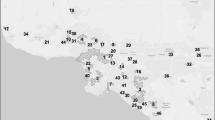Abstract
Suburban development in the US is widely criticized for its contribution to automobile dependence and its consequences. Not surprisingly, then, a return to more urban-style development, where potential destinations are closer to home, is often put forth as a strategy for reducing automobile dependence. This paper evaluates the possibility that providing local shopping opportunities will help to reduce automobile dependence by exploring how residents of existing neighborhoods make use of the local shopping opportunities currently available to them. Using both quantitative and qualitative evidence for six neighborhoods in Austin, TX, we address two sets of questions. First, to what degree do residents choose local shopping over more distant opportunities and why? What are the implications for vehicle travel? Second, to what degree do residents choose to walk rather than drive to local shopping and why? What are the implications for vehicle travel? The results of this exploration suggest that local shopping will not prove a particularly effective strategy for reducing automobile dependence in the typical US city by either reducing travel distances or encouraging alternative modes of travel. Residents of such places choose more distant stores enough of the time that they increase total driving significantly, and they don't choose alternative modes enough of the time that they reduce total driving significantly. But while local shopping may not do much to reduce driving it does give residents the option to drive less and this option is something residents clearly value. Local shopping does not show great promise as a strategy for reducing automobile use, but it does show promise as a strategy for enhancing quality of life in neighborhoods, at least partly by making driving once again a matter of choice.
Similar content being viewed by others
REFERENCES
Ampt E & Rooney A (1998) Reducing the Impact of the Car, A Sustainable Approach: TravelSmart Adelaide. Paper prepared for the 22nd Australasian Transport Research Forum, Sydney, Australia, 30 September-2 October.
Beyond Sprawl: New Patterns of Growth to Fit the New California (1995) San Francisco: Bank of America, California Resources Agency, Greenbelt Alliance and Low Income Housing Fund, January.
Fotheringham A & Trew R (1993) Chain image and store-choice modeling: The effects of income and race. Environment and Planning A 25: 179–196.
Hamilton WL (1999) How suburban design is failing American teenagers. The New York Times (May 6): B1, B11.
Handy S (1992) Regional Versus Local Accessibility: Variations in Suburban Form and the Implications for Nonwork Travel. Unpublished dissertation, Department of City and Regional Planning, University of California at Berkeley.
Handy S & Clifton K (2000) Evaluating Neighborhood Accessibility: Issues and Methods Using Geographic Information System. Research Report SWVTC/00/167202-1, Southwest Region University Transportation Center, The University of Texas at Austin, November.
Handy S, Clifton K & Fisher J (1998) The Effectiveness of Land Use Policies as a Strategy for Reducing Automobile Dependence: A Study of Austin Neighborhoods. Research Report SWUTC/98/467501-1, Southwest Region University Transportation Center, The University of Texas at Austin, October.
Holton R (1958) The distinction between convenience goods, shopping goods, and specialty goods. The Journal of Marketing (July): 53–56.
Lincoln Institute of Land Policy (1995) Alternatives to Sprawl. Cambridge, MA.
Mokhtarian PL & Salomon I (1999) How Derived is the Demand for Travel? Some Conceptual and Measurement Considerations. Institute of Transportation Studies, University of California at Davis, June.
Nevin JR & Houston MJ (1980) Image as a component of attraction to intraurban shoppping areas. Journal of Retailing 56(1) (Spring): 77–93.
Newman PWG & Kenworthy JR (1989) Cities & Automobile Dependence: A Sourcebook. Brookfield, UK: Gower Technical.
Padgett T (1999) Saving suburbia. Time (August 16): 50–51.
Riddle L (1999) At celebration, reasons to celebrate. The New York Times (March 7): 42.
Robinson RVF & Vickerman RW (1976) The demand for shopping travel: A theoretical and empirical study. Applied Economics 8: 267–281.
Tauber EM (1972) Why do people shop? Journal of Marketing 38 (October): 46–59.
Author information
Authors and Affiliations
Rights and permissions
About this article
Cite this article
Handy, S.L., Clifton, K.J. Local shopping as a strategy for reducing automobile travel. Transportation 28, 317–346 (2001). https://doi.org/10.1023/A:1011850618753
Issue Date:
DOI: https://doi.org/10.1023/A:1011850618753




